Traditional Songs from Georgia
(Naxos World 76014-2)
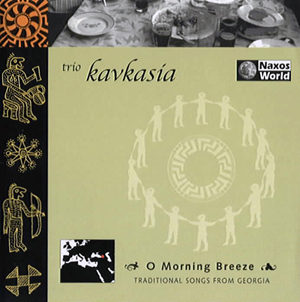
On this page you will find more extended liner notes than would fit in the printed CD booklet, plus the complete lyrics for each song, plus photos.
| Kavkasia | return to Kavkasia home page |

|
Georgia and its music
Georgian tuning
Georgian instruments
map of Georgia
EXPLANATORY NOTES FOR EACH SONG, WITH COMPLETE LYRICS further resources how to buy this CD return to Kavkasia home page |
| Georgia and its music |
|
The Georgian people, inhabiting a land the size of West Virginia wedged between Russia and Turkey, speak a group of languages related to no other outside the Caucasus Mountain region. Georgia is an island musically as well, exceptional in having an ancient, deep-rooted tradition of polyphony (music in several independent voices), while all the cultures that surround it, and all the cultures that have occupied or passed through it, are firmly monophonic. Georgian polyphony appears to be truly autonomous and original, and its rules of counterpoint and tuning derive from nowhere else. Three-part singing in Georgia was probably in full flower by the ninth century, substantially preceding the modern development of polyphony in Europe. The density and complexity of the polyphony you hear on our album is traditional — none of these songs is a setting of old material in a modern idiom. |
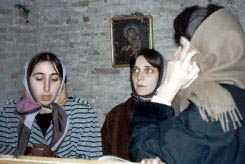
a choir of three women singing for a wedding |
Within Georgia, the most significant musical differences coincide with the ancient and long-enduring division of Georgia into eastern and western kingdoms. In the east, the many centuries of control by Persia are reflected in the assimilation of a Persian melismatic vocal style to essentially Georgian musical forms, while in the west the older native forms persist largely intact. But even within the traditional east and west, local regional identity, based on geographical and historical divisions, remains very strong, and the regional musical traditions are remarkably distinct for so small a country.
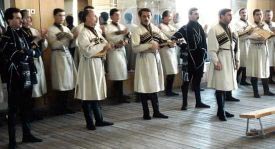
the State Ensemble backstage before a concert
Georgian folk music was an entirely oral tradition before the 1880s. Many song transcriptions now exist, but European musical notation remains inadequate to capture the unique Georgian intervals and scales (discussed below), and even now, in professional ensembles as well as village choirs, most songs are still learned by ear. In the absence of a truly accurate system of notation, recordings are a vital resource in understanding and preserving this music. The early field recordings of Georgian folk songs, starting in 1907, provide only a snapshot in time of a music that had developed along a fluid but irreproducible course over many centuries, but they are the oldest documentation we have for the folk music.

Bolnisi Church, built 479 - 493 AD |
Georgian liturgical music, on the other hand, has been documented since the Middle Ages. Georgia formally embraced Christianity in the fourth century, before the Roman Empire did. Between the fifth and eighth centuries, scholars in several Georgian monasteries — in Greece and Palestine as well as in Georgia — began composing music for the liturgy. Certainly by the twelfth century, and possibly as early as the eighth and ninth centuries, the Georgian liturgy was being sung in three-part polyphony. Those settings were written down and preserved. Some of the manuscripts still exist, but their musical notation (marks placed above and below the syllables of text) can no longer be understood. |
We cannot be sure, therefore, how closely the settings now in use correspond to the most ancient manuscripts. But the liturgical music in its current form certainly predates the seventeenth century, when the chants were transcribed using a new (though still specifically Georgian) system of notation, which can still be deciphered. Yet mapping old Georgian note symbols onto European note names does not reveal how the original intervals and chords were tuned. The issue of how the liturgical music was tuned before the age of the piano presents a broad and fertile field for speculation, producing some of the most interesting and controversial musicology, as well as musical practice, now going on in Georgia.
Many of the intervals and chords you hear us sing on our album might be a little disconcerting on the first (or tenth) listening, and, if you're familiar with our first album, you may notice that we sound different now. Our model for Georgian singing, in vocal timbre as well as in tuning, has shifted from the highly polished but rather homogenized sound of the professional urban singing groups to a more region-specific, less European-influenced sound. Some of the professional ensembles in Georgia have themselves been moving in the same direction.
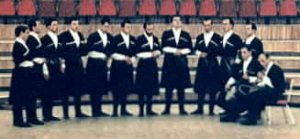
Georgika, a professional ensemble of young Georgians
who are also exploring traditional tuning
One ingredient of the more traditional sound we're after is a unique sense of where the steps of the scale ought to be: Georgian singers consistently sing intervals and tune chords in ways that are at odds with historical European practice. The goal of this trio is now to sing this music the way we hear non-Western-trained Georgian singers doing it, whether in present-day villages and regional ensembles or on old field recordings. We believe that those singers know what they're doing and that the intervals they sing are not arbitrary but grow from the fundamental structure of the music.
|
Neither those assumptions nor all of the conclusions we draw from them are universally shared. In spite of decades of musicological study, traditional Georgian tuning is a puzzle that has not yet given up all its answers. In our own search we have drawn inspiration from old recordings and from contemporary Georgian scholars; the tunings we use on our album seem to us consistent both with actual village practice and with an emerging theoretical model worked out by one of us (Stuart) and by a fellow Georgian music specialist, Guy Brewer. |

Carl and Alan taping eminent Gurian singer Vazha Gogoladze as he sings one voice part of a trio at a time |
You don't have to know the theory to enjoy the music, but here's a brief and incomplete sketch: In general, in music with true three-part polyphonic independence and a small melodic range, fifths will be more important than octaves. The fifth will replace the octave as the unit of structural stability and pitch equivalence, and the scale will repeat at the fifth instead of the octave. We can usefully speak of such music as being built around the "quintave" rather than the octave. In a scale based on the quintave, furthermore, the tendency will be to subdivide the fifth not into whole and half steps but into four intervals more nearly equal in size, blurring or erasing the sense of major and minor. Those intervals produce a lowered second, a near-neutral third, and a raised fourth — which, when projected by a fifth, results in a raised eighth degree, a wide octave. The effects of this tendency vary by region in proportion to the tradition of true three-part polyphony, but some form of quintave tuning is common to almost all Georgian music.
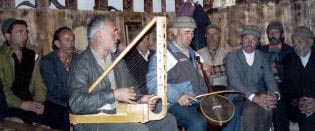
traditional tuning still thrives in Svaneti
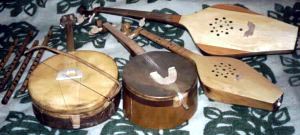
salamuri flutes, two chunirs, a panduri, and a chonguri
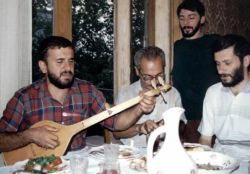
Malkhaz Erkvanidze (with members of the Anchiskhati Choir) playing the chonguri |
The chonguri is a long, four-stringed, fretless lute that can be plucked or strummed. The highest string is an unfingered half-length drone string. The chonguri in its present form emerged around the middle of the eighteenth century in Samegrelo; its use has long since spread to the rest of western Georgia. Like the other Georgian string instruments, the chonguri is chiefly used as support for vocal music, though some virtuoso solo pieces exist. |
|
The panduri is a strummed three-stringed fretted lute from eastern Georgia. The characteristic flat-fifth tuning of the panduri is the result of frets that divide the octave into seven roughly equal steps, producing a low major second, a high minor third, and a high fourth, all of which are consistent with quintave scales, but also a low fifth, which is unique. The fifths can be, and often are, slightly improved at the expense of the unisons between strings. |
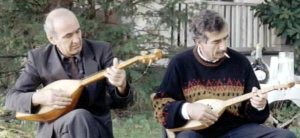
members of the Rustavi Ensemble playing a bass panduri and a panduri |
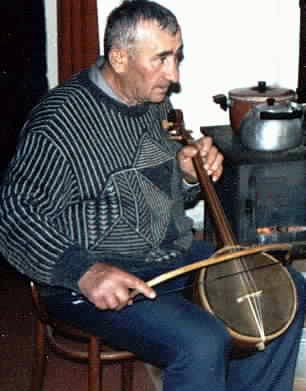
Islam Pilpani playing the chunir |
The chunir is a three-stringed fretless viol, skin-faced and open-backed, about the size of a banjo but bowed like a cello — except that the bridge is flat, so all three strings are always heard. Unlike the panduri and the chonguri, which are used throughout eastern and western Georgia respectively, the chunir belongs exclusively to the music of the northwestern mountains. |
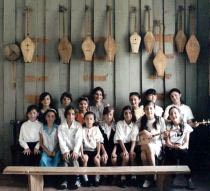
girls of the children's choir of Mestia, in Svaneti
http://www.georgianassociation.org
the homepage of the Georgian Association in the United States: lots of resources and links
http://www.sakartvelo.com/indexOLD.html
a fun, comprehensive site about Georgian culture, history, current events, wine, etc., by journalist Giorgi Topouria
Darra Goldstein, The Georgian Feast
(HarperCollins, 1993)
an excellent Georgian cookbook for non-Georgian kitchens
George Hewitt, Georgian: A Learner's Grammar
(Routledge, 1996)
how to teach yourself Georgian relatively painlessly
Kevin Tuite, An Anthology of Georgian Folk Poetry
(Fairleigh Dickinson University Press, 1994)
a scholarly edition of 70 poems, with transliterations and translations
Marjory Scott Wardrop, The Man in the Panther's Skin
(first published 1912; out of print except in Soviet editions;
click here to see the complete text of Wardrop's translation)
the first English translation of Shota Rustaveli's 13th-century epic poem
| NOTES on the SONGS |
To jump to a specific song, click on its title below.
| Benia's Mravalzhamier (Long Life) |
Long life!
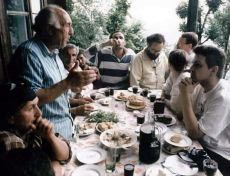
making a toast |
A Mravalzhamier needs an identifier like "Benia's" because this traditional song of congratulation and good wishes comes in dozens of musical settings from all over Georgia. Some have additional text in the same vein, but most, like this version, use only the word mravalzhamier, stretched out, broken up, and sometimes injected with stray vowels. A Mravalzhamier would customarily be sung at the banquet table, as part of the elaborate ritual of toasts and accompanying songs (see Guruli Vakhtanguri for another of these), but it's surprising in how many other contexts it can come in handy. |
|
The late Benia Mikadze was the leader of the Imeretian regional ensemble Sanavardo, and into his eighties he was a formidable champion of folk music. When Anzor Erkomaishvili invited Benia to appear on his folk-music TV show, he introduced him with the usual platitudes, ending with "And now it's my honor to welcome Benia Mikadze." Benia, tiny, gaunt, white-bearded, leaned into the microphone, pointed a challenging finger at Anzor, and, without saying a word, sang out the first note of a Gurian toasting song — a song that required Anzor to come in with the next voice just one note later. Anzor is not your average talking head, and after just a millisecond with his mouth hanging open he came in correctly, and our friend Malkhaz Erkvanidze from the Anchiskhati Choir (who were all waiting in the wings to sing with Benia later in the show) hustled on stage a moment later, just in time to supply the third voice. It made great TV. |

Malkhaz Erkvanidze of the Anchiskhati Choir and Anzor Erkomaishvili of the Rustavi Ensemble |

Benia Mikadze [photo: V. Markarova] |
Both Malkhaz and Benia came from the Imeretian town of Samtredia, in an area where the music carries influences from both Guria and Imereti — regions whose styles are closely related anyway. This Mravalzhamier setting, either Benia's own invention or at least a version he adopted as his signature song, leans musically toward Guria. Malkhaz, whose father sang in Benia's ensemble, transcribed it when he was an ethnomusicology student. Years later we came across Malkhaz's transcription by roundabout means, learned it, and casually launched into Benia's personal Mravalzhamier the next time we were at table with the Anchiskhati Choir. Malkhaz froze, his fork halfway to his mouth, the look on his face almost as good as the one on Anzor's when Benia suddenly began to sing. |
| Chkimi Toronji (My Dove) |
1. I was twelve years old. I wanted to catch a dove,
My own heart's sweetness, to raise by hand.
2. We all want to travel one road — I had to go there.
I wanted to return soon, having reached my goal.
3. My dove wasted away, it flew away.
I can't stand, can't sit, until it returns.
4. My dove was attacked, doomed never to see old age.
Forever was sealed your fate and mine.
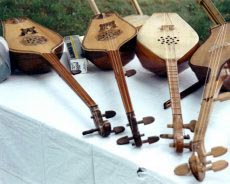
three chonguris and a bass panduri |
Though some songs are many hundreds of years old, folk music in Georgia is still a living form, and new songs in the traditional styles are being created even today. Chkimi Toronji, whose plaintive, melancholy tone is characteristic of a whole genre of traditional "heartbreak" song, was composed around 1931 by a husband-and-wife team, Beglar and Kionia Akobia, with words by Beglar's uncle, Pavle Akobia. The Akobias came from Zugdidi, so the text is in Megrelian, the language of the western Georgian lowland region of Samegrelo. Megrelian differs from Georgian about the way German does from English: there are many obvious cognates, but the languages are not really mutually intelligible. (Megrelians grow up speaking both.) Though Carl once met the Akobias' daughter, we actually learned this song from an old Melodiya LP by the choir of the Megrelian village of Tsalenjikha. The accompanying instrument is the chonguri. |
| Movedit da Vsvat (Come, Let Us Drink) |
Come, let us drink the new sustenance,
Not sprung from hard rock
But flowing from an ever-pure spring
Issuing from the very grave of Christ,
And by which we have been renewed.
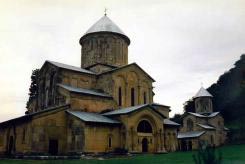
Gelati Cathedral, in Imereti (12th - 18th century) |
The medieval liturgical music composed in Georgian monasteries comes in two styles: eastern ("Kartli-Kakhetian" — see Jvarsa Shensa) or western ("Gurian"). The differences between them parallel the differences in the folk music of east and west: in the east, more triadic chords and greater importance of the middle, more melodic voice; in the west, fewer triads and greater independence of the parts. In addition, chants in the western Georgian style (also called the "Gelati School" after the principal medieval monastery identified with it) fall into two modes, simple and mixed, where the relative independence of the lines is again the issue. Movedit da Vsvat, a chant for the Eucharist, is an example of the western Georgian mixed-mode style. In keeping with the long tradition of written rather than orally preserved liturgical music, we learned this from a book, Kakhi Rosebashvili's 1976 collection of Georgian hymns in the Gurian style (Kartuli Galoba: Guruli Kilo). Rosebashvili recorded and transcribed the parts as remembered by older singers, notably Artem Erkomaishvili, the great-uncle of our friend and mentor Anzor Erkomaishvili. But Rosebashvili's transcriptions are piano-ready and therefore no help in deciding questions of tuning. We tune the liturgical music the same way we do the folk music: the same methods of counterpoint construction apply, bringing with them the same imperatives of tuning by quintaves instead of octaves, and scalar motion by intervals that lie between a half and a whole step. |
| Gogo Shavtvala (Black-Eyed Girl) |
|
1. Black-eyed girl, woman, darling, The eastern Georgian regions of Kartli and Kakheti share most of their musical repertoire, though their styles of performance are distinctive. This ballad contains both styles: the triplet meter of the choral section suggests Kartli, while the melismatic, highly ornamented, Persian-influenced vocal style of the solo is typical of sun-parched Kakheti, famous for its vineyards. |
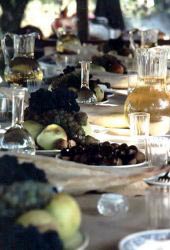
a Kakhetian feast table |
| Shavi Shashvi (The Black Thrush) |
1. The black thrush spoke. I wonder what he said?
2. There goes a deer! Bark at him, dog!
3. Bark at him, Mura! Catch the deer!
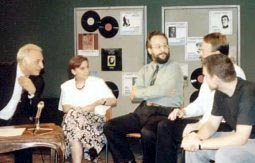
Anzor Erkomaishvili interviewing Kavkasia on his TV show, "100 Georgian Folk Songs" |
Much of the folk repertoire from Guria, in the steep hills and hollows of southwestern Georgia, is characteristically sung by a trio: strictly one voice to a part, so that each singer can improvise and embellish freely. As with most Gurian trios, there's not much text in Shavi Shashvi, and what little there is goes by in three quick bursts. But some of what may sound like nonsense isn't: "ali!" is what you say to urge a dog on, and "am! am!" is what Georgian dogs say instead of "bow wow!" To explain how we learned this and several other songs on our album, it's necessary to introduce Anzor Erkomaishvili, the director of the renowned professional Rustavi Ensemble, based in Tbilisi. Anzor is also the most visible and best-connected advocate of Georgian folk music around, partly through his weekly TV show, "100 Georgian Folk Songs," which he uses to spotlight the work of musicians old and new. (He put Kavkasia on the show and made us overnight celebrities.) Anzor is a scholar and a fierce preserver of the old singing traditions, and himself the last in a long line of famous singers: the Erkomaishvili Brothers were giants of Gurian trio music before the First World War. |
|
We sort of knew one version of this particular and essential Gurian trio before we went to Georgia. But when Anzor learned that we intended to perform Georgian music in America as a trio, he said, "Forget that Shavi Shashvi you know — I'm going to teach you the version my grandfather and his brothers sang." And so he did. Though he was seriously ill at the time, we were summoned to his bedside. At first he could barely lift his head from the pillow to sing us our parts, but note by note, line by line, voice by voice, he pieced together the song in our heads. The process took all day, including a break for a grand dinner, during which Anzor — still lying down but within reach of the table — prompted us to deliver the string of ritually required toasts in the proper traditional order, while those fragments of Shavi Shashvi already lodged precariously in our heads began to dissolve away in wine. Then we went back to work again. As the hours passed and we gradually wilted, Anzor got steadily stronger, till he was sitting up and gesticulating to correct us, while his wife and his elderly mother hovered anxiously nearby, trying to restrain him. But we couldn't leave till he had heard us sing Shavi Shashvi flawlessly from top to bottom. Part of what Anzor was really teaching us — while we thought he was just teaching us another variant of a song we knew — was the grammar by which allowable and cool new variants are constructed, and the version we now sing incorporates some moves of our own. |
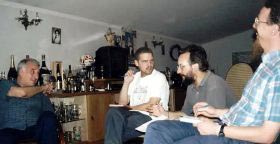
Anzor teaching us a song |
| Mirangula [a man's name] |
1. Mother's Mirangula,
Mother's boy, she had only you.
2. He has gone up to the tower.
She brought you dinner in the tower
3. Oh, may Wednesday be cursed!
She has taken up dinner.
4. Mirangula was not there,
Mother's Mirangula.
|
Svaneti, in the harsh environment of the high Caucasus Range, supports a sparse population of rugged, self-reliant people, isolated from the culture of lowland Georgia. For centuries, the Svans fought a perpetual low-level war against the Muslim inhabitants of the north slopes of the Caucasus (see Riho for one instance of this). All over Svaneti, villagers built clusters of single-family defensive towers in which to hide during raids; most of those towers still stand, giving Svan villages their characteristic odd medieval high-rise look. |

medieval towers in Svaneti |
Mirangula is a folk poem in the Svan language, a distant relative of Georgian. While the poem is more than a hundred stanzas long, the song uses only a few lines from near the beginning. Since it is a spoken rather than a written poem, there are many variants, but here is a quick summary of the whole story: Mirangula is spoiled by his mother, who keeps him in the family's defensive tower. He runs off — in spite of her warnings of doom — to fight the Balkarians across the pass. He shoots nine men and captures their oxen. He is pursued on his way home, and eventually he is shot. As he falls, God grants his wish for revenge and he shoots his killer before he himself dies. His body will be divided among the wild animals. Meanwhile, a group of Svan priests held captive by the Balkarians escape. On their way home they come upon Mirangula's body. They herd home the oxen he stole and offer them up at a funeral feast. So many are gathered at the banquet that the floor collapses, and many are injured. (This account is drawn from "An Anthology of Georgian Folk Poetry," by Kevin Tuite.)
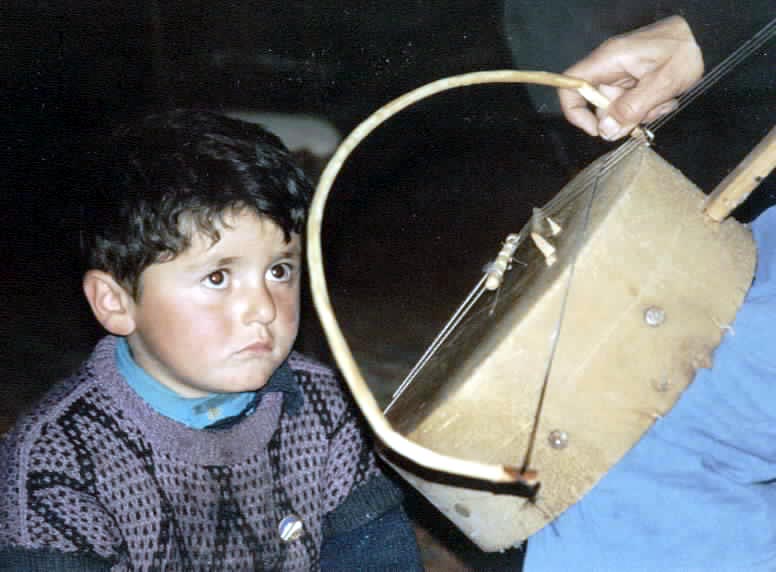
a woman playing the chunir for her son |
The accompanying instrument is the chunir. Stuart's first chunir teacher was Islam Pilpani: farmer, carpenter, and unrivaled master musician of Svaneti (as well as regional chess champion). Islam leads the regional folk ensemble Riho, which draws singers from the regional capital Mestia and the villages around it and includes almost all the people who have been our mentors for Svan music. |
| Aghdgomasa Shensa (Your Resurrection) |
Your resurrection, Christ, Lifegiver,
The angels sing in the high heavens.
And we have been redeemed, every one,
By the Holy One's heart. Glory to you!
|
This Easter hymn and its companion piece, Kriste Aghsdga, are in the simple mode of the western Georgian "Gelati School" style. We perform these hymns the way they are done by the Anchiskhati Choir, a tight-knit, highly motivated band of a half-dozen young conservatory graduates who serve as the choir of the venerable Anchiskhati Church in the old quarter of Tbilisi. As musicologists and as singers they are leading and shaping the revival of the western Georgian style of the sung liturgy, specializing in the simple mode. We met them by attending service at their beautiful fifth-century church one Sunday morning and listening to them. They befriended us immediately; in fact, the service was barely over before they had cornered us against the ancient stone wall outside, already trying to figure out what crazy Gurian trios we knew. |
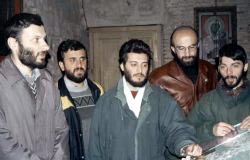
members of the Anchiskhati Choir in church |
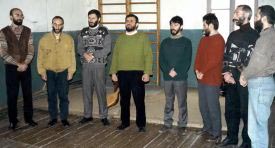
the Anchiskhati Choir performing folk songs in a village school |
In the years since that first meeting, our warm embrace by the Anchiskhati singers has led to passionate debate over everything from theology to the authentic tuning of Georgian music. They don't entirely endorse our tuning approach, and we're curious to hear what they think of our new album. Still, they have had a profound influence on Kavkasia's repertoire, tuning practice, and even vocal timbre — and they know more of the words to "The Sound of Music" than we do. |
| Shirakis Velze (On the Shiraki Plain) |
1. I am traveling on the Shiraki Plain.
The wind bids me turn back.
Ahead I see a butterfly,
The red of whose wing
Resembles my beloved's dress.
God, mark me with the sign of the Cross.
2. Across the way there is a big valley,
Full of violets and roses.
There sits a beautiful woman,
Gracefully bowing her head.
What does she need a comb for?
Her braid is golden.
3. If only I could be like an eagle,
The breeze would take me to you.
I would lift the corner of your blanket,
And carefully watch you sleep.
I would keep you from shame
And protect you from harm.
|
An eminent painter we knew, scandalized to hear that we weren't learning any poetry as part of our Georgian language lessons, taught us the mysterious first stanza of this song, not as lyrics but as spoken verse. As a memory aid he illustrated each line with a fast charcoal drawing — road, wind, butterfly, dress, cross. We repaid him by teaching him "I'm a Little Teapot," complete with gestures. We learned the other stanzas and the musical setting on a weekend hunting expedition to the easternmost tip of Georgia. Our hunting friends had brought along very little water and not nearly enough spare tires, but they had wine sufficient for ten times our number, and plenty of musical instruments. Camped out under the moonlight, they sang lots of songs, but this one they sang over and over again: the arid, treeless expanse of sunflower fields in the middle of which we had broken down turned out to be the Shiraki Plain. |
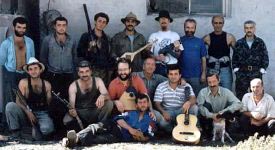
our hunting party |
The text is much older than the musical setting, which is contemporary, though in traditional folk style. The melody came first, for a soloist accompanying himself on the panduri. While the panduri is common in the music of Kakheti, and the text of the song refers to easternmost Kakheti, the musical style — unornamented melody with subordinate outer parts of much later date — suggests that this song is actually from the northeastern Caucasus mountain region of Tusheti. (So that traveler on the desolate Shiraki Plains is far from home.) This arrangement for three voices, in the folk idiom of other songs for panduri, was created in 1980 by the Tbilisi-based folk ensemble Kolkheti. It's pretty close to what a group of gung-ho though unschooled musician/hunters, not coached in this song but immersed in the style, came up with after a few dozen verses to get in the groove.
| Megruli Naduri (Megrelian Work Song) |
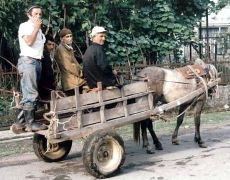
a horse-drawn farm cart |
This is a work song with a text consisting entirely of nonsense syllables — but exactly prescribed syllables that you can't switch around, any more than you could sing "la la fa" in an English madrigal. There are naduris of all flavors from all over Georgia, each of which originally accompanied the nadi, the shared work, such as harvesting, traditionally done by a community's farmers on each of their lands in turn. As in most work songs everywhere, a soloist sets the pace for song and work. Out in the fields this song undoubtedly went on for much longer than we do it. We have heard a group of farmers from the region of Imereti do a naduri that lasted more than ten minutes, and even that was just their concert version. You wouldn't think so from the title, but the short naduri we do actually comes from the region of Lechkhumi, in the highlands of north central Georgia. At the time we recorded it, we thought it was native to the neighboring lowland region of Samegrelo, because that's what the choir of the Megrelian village of Chorotsku told Carl when he visited the village and sang it with them. (We had learned the song from the Melodiya LP recorded by that choir.) But after the release of our album we discovered that this naduri is generally believed to have originated in Lechkhumi, even if it migrated to Samegrelo long enough ago to be considered local repertoire there. |
| Riho (Sunrise) |
1,3 Sunrise. You were praying to God at the wall of St. Mary's in Ushgul.
2,4,5 Sunrise. They were fighting the enemy.
6 Sunrise. Your young men are all gone.
|
The highest village in Svaneti is Ushgul, higher than any village in the Alps inhabited year-round. From Ushgul, sometime long ago, all the young men set out on a raid through the mountains against a village of Muslim Balkarians on the north slopes of the Caucasus. Only one man returned. The cryptic Svan text of Riho commemorates that event. Sustaining the Svan reputation for toughness, the person who translated the text for us assured us that the song is not a lament, but a celebration of the heroism of the survivor. The music of Svaneti is another heroic survivor: the ancient musical forms are better preserved in Svaneti than anywhere else in Georgia, and the importance and seniority of Svan music are clear to other Georgians singers. The music of no other region has so successfully withstood the influence of piano temperament and other unfriendly modernization. Riho shares with Zar a primordial language of tightly confined vocal lines, simple repetitive movement, and uncompromisingly non-Western scales. |
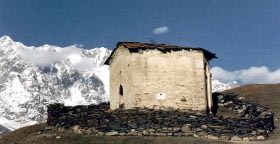
St. Mary's Church in Ushgul (Middle Ages) |
| Piruzi (Turquoise [a woman's name]) |
1. From high above came Piruz.
2. She waves at me to come over, Piruz.
3. I went up and sat her next to me, Piruz.
refrain: Piruz, Piruz, the panduri's duckaboo.
Duckaboo and heart's rose, we say she's a beauty!
|
If you're not sure what "duckaboo" means, neither are we. It's our attempt to translate kwatito, which doesn't mean anything in Georgian, though kwati means duck in Gurian dialect. Whether for that or more mysterious reasons, every occurrence of kwatito in this little Gurian trio sends Georgians young and old into giggles: a disconcerting thing for a singer the first time it happens. As for how a duckaboo could belong to a musical instrument, space limitations sadly prevent us from giving a full explanation here. Anzor Erkomaishvili taught us Piruzi before dinner at his house on the very last evening of our first long stay in Georgia — one for the road, in a way. The whole time we were working on the parts with him, a small child in his household marched from room to room irrepressibly chanting "kwatito!" |
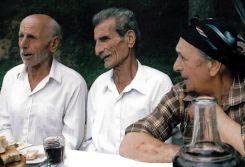
a mixed trio from the Gurian village of Tav Surebi |
| Kriste Aghsdga (Christ has Risen) |
Christ has risen,
And by dying has conquered death.
We need no longer fear the grave.
He is the giver of life.
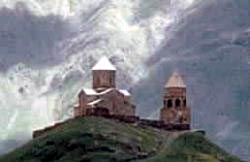
Tsminda Sameba ("Holy Trinity") church, near Qazbegi (14th century) |
Kriste Aghsdga, an Easter hymn in the simple mode of the western Georgian "Gelati School" style, shares with Aghdgomasa Shensa and the hard-to-place Tsmindao Ghmerto a three-fold iteration of its brief material, evoking the Trinity. The three voice parts used in all Georgian liturgical music (solo passages never occur) are also considered to represent the Trinity — whether only in retrospect or as the conscious plan of the medieval monastic composers of these settings. The liturgy is not complete until the three voices meet as one, signifying the union of the Trinity; any chant that ends on an open fifth is unresolved, signifying that the service will continue. Only the liturgical pieces on our album begin with all three voices together, while all the folk songs, except for the handful that have an instrumental lead-in, begin with a solo, even if a very brief one. That's a practical necessity in folk music: without a conductor, you need either a soloist or an instrument to pitch the song and set a tempo (and, at an informal setting like a dinner table, even to let all the singers know what the next song is). In the liturgical music, the three parts do start together, but within the context of a church service all these pieces would immediately follow a text chanted by a priest — who then effectively serves as the introducing soloist. |
| Utsinares Mas Vadidebt (First of All, We Praise Him) |
1. First of all, we praise Him who made sea and dry land,
Whose eternal existence is immortal and imperishable.
2. He saved us from Hell and brought us the light of life.
We ask Him to deliver us from danger and evil.
3. Shalva, my darling, you are sweeter than life.
You were born and raised to bring me hope.
4. Oppressed by fate, enduring great misfortune,
I burn inconsolably. I beg you to bring me relief.
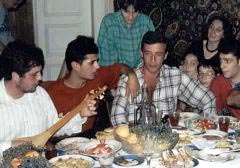
members of Mtatsminda, the Tbilisi University ensemble, singing with a chonguri |
We learned this ballad from our friends in the Anchiskhati Choir, who first sang it for us at parties, and from an old recording by Benia Mikadze and his ensemble, Sanavardo. Like much of the secular repertoire inherited from Sanavardo by the Anchiskhati Choir, Utsinares comes from the area around the town of Samtredia, where a nominally Imeretian song like this one can have a lot of Gurian shadings. The accompanying instrument is the chonguri. In spite of the religious tone of part of the text, this is not sacred music: only the liturgy itself is sung in the Orthodox service, and no instruments are permitted in church music. Instead these lines are drawn from the Tamariani, a 19th-century epic poem by Simon Gugunava. The first two verses comprise one rhymed quatrain, from the solemn dedicatory introduction to the poem. The last two verses form another quatrain, drawn from much later in the same poem, after everybody already knows who Shalva is. The "Shalva" quatrain turns up in several other songs that need a dose of text, and one whole Gurian song is actually entitled Shalva Chemo Siqvarulo ("Shalva, My Darling"). |
| Me Rustveli (I, Rustaveli) |
1. I, Rustaveli, have composed this work by my art.
2. For her whom vast armies obey, I lose my wits, I die!
3. I am sick from love, and for me there is no cure anywhere,
4. Unless she give me healing, or the earth a grave.
5. This world is mostly false and unreliable.
6. Show me one person who is content.
|
The poet Shota Rustaveli towers over Georgian literature like Homer and Shakespeare rolled together. He lived toward the end of Georgia's twelfth-century Golden Age, a time when a rich, politically stable, and territorially expansive Georgian kingdom dominated the Caucasus region. The great ruler of that time was a woman, Tamar, the Georgian equivalent of England's Good Queen Bess. Rustaveli dedicated his epic poem of courtly love and knightly adventure, "The Man in the Panther Skin" (Vepkhistqaosani), to Queen Tamar, and the first four verses of this song consist of that famous dedicatory quatrain. (The English version given here is adapted from the 1912 prose translation by Marjory Scott Wardrop.) As with most Gurian trios, of which this song is a preeminent example, any real text comes wrapped in lots of nonsense words, and a single line of poetry is more than enough material for an entire verse of music. In contrast to that high formal literature, the last two verses use as their text a rhymed couplet of anonymous folk poetry, whose simplicity and darkness could not be more distant from the extravagant courtly compliments of Rustaveli's quatrain. No one knows what Gurian singer first joined these two worlds, but nothing unites them except the music, which rolls on impervious to any sudden shift in textual tone. An essential property of Georgian folk music in general — Gurian trios only take it to an extreme — is that the musical setting is opaque: the music follows its own imperatives and gives no cues as to high or low tone, happy or sad mood in the text. While the singers may do different ingenious variants on every verse, the musical mood stays fixed throughout, and nothing in the text is highlighted or telegraphed by the music: Gurian trios are not Schubert lieder. |
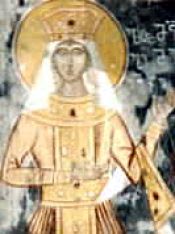
Queen Tamar: fresco from Gelati Cathedral |
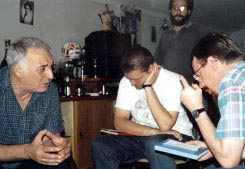
at school with Anzor Erkomaishvili |
Musically, Me Rustveli follows the (not so obvious) rules of highly polyphonic Gurian counterpoint. The parts have certain landmark pitches; between those points they may move with considerable freedom, which is what makes it possible to mix and match different variants without prior coordination — they all work. Anzor Erkomaishvili first taught us this song, by the exhilarating but brain-straining process described in the note to Shavi Shashvi. He chose a few of his favorite variants from old recordings for us to learn; since then we have added a few more that we picked up here and there, just to tickle him. |
| Tsangala da Gogona (Tsangala and the Girl) |
refrain: Tsangala and the girl! Girl, girl, girl, girl!
1. Tsangala went to town, he brought back grapes.
He ate them himself! He digs our graves!
2. This boy dances so well on his tiptoes,
If he falters, he'll blame the girl.
3. This boy dances so well on his tiptoes,
If he falters, who will he blame next?
4. My darling, my brother, you look like an archangel.
Your cap is cocked to one side, you look like a hero.
|
At many banquets we have attended, when the first four or five hours at the table have gone by and people's spirits are high and their feet are restless, a dance song, like this one from the Kartli region of central Georgia, can propel a few lively souls — and by no means always the youngest or the thinnest — in a rapid circle around whatever open floor remains next to the line of crowded tables laid end to end. Men and women spiral around each other, never touching. The men prance and caper like gallant roosters, sometimes on the knuckles of their toes like Tsangala, while the women glide gracefully around with such tiny steps that they seem to have wheels for feet. As for the singers left at the table, deep in wine and singing and clapping faster and faster, it's a good thing for them the parts to this song are simplicity itself — though at full speed the words are another matter. |
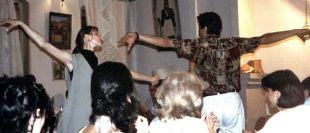
dancers at a party |
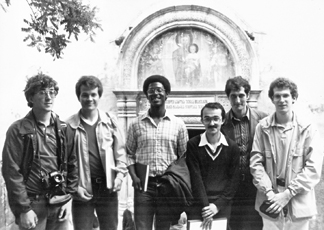
future Kartuli Ensemble director Greg Salmon (far left) and Yale Russian Chorus director Guy Brewer (center) with Georgian choirmaster Edisher Garakanidze (second from right) outside Sioni Cathedral in Tbilisi in 1982 |
Tsangala has been rattling around the collective repertoire of Americans who sing Georgian music longer than any other song on our album. All three of us in Kavkasia came out of the Kartuli Ensemble, a larger amateur group founded in 1985, which in turn was born out of the Yale Russian Chorus, a university group that has performed mostly Russian choral music since 1953, and which added a handful of Georgian songs to its repertoire in the late Sixties. The first small hint that there might be life for Georgian music in North America out from under the shadow of Russian music came in 1980, when five members of the Yale Russian Chorus (including Stuart) performed a specially prepared all-Georgian set at an annual student-run recital, called "Sheep's Clothing," devoted to avant-garde music — an event where the usual fare involved music majors in tuxedos dropping dining-hall cutlery into the grand piano. The three Georgian songs, of which Tsangala da Gogona was one, were performed without introduction or explanation; they caused a sensation. |
Georgian folk music has been attracting the interest of forward-looking composers at least since Stravinsky, and the quintave tuning system we have been exploring in the past few years has already fired the imaginations of several microtonally inclined American composers. (Our Tsangala turns away from the bright major-mode version familiar to most urban, piano-conscious Georgians, and looks instead to the traditional neutral-tuned versions to be found on recordings of village choirs.) Who knows, Georgian music may in the end prove a greater threat to the piano than cutlery.
| Jvarsa Shensa (Your Cross) |
We venerate your cross, O King,
And your holy resurrection.
Praise to you and hymns of glory!
|
Liturgical music in the eastern Georgian or Kartli-Kakheti style, of which this Easter chant is an example, has been especially susceptible to modern straightening out of the tuning for European-classically trained ears. As explained in the introductory notes, any reconstruction (including our own) of how this music was tuned between the years 900 and 1900 is at best informed speculation. The earliest Georgian liturgical transcribers with European training are commonly said to have made gross errors in their notation of accidentals, or even failure to notate them. Late-twentieth-century common practice, in church and on the concert stage, is to perform the Kartli-Kakheti liturgical music in something close to European Just intonation, but we ourselves, along with our colleague Guy Brewer, are trying to find a more historically plausible system of tuning. If the assumption governing our own performance of this piece is right — that the liturgical music should properly be tuned like the secular music that surrounds it — then any transcriber working with only the twelve tones of the piano keyboard would indeed be forced to make one wrong choice of accidental after another, or give up accidentals entirely. (Modern transcriptions of Georgian music are replete with arrows to show microtuning.) |
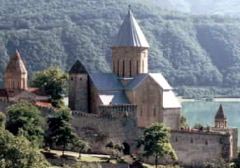
Ananuri Church in upper Kartli (16th - 18th century) |
| Lazhghvash (Leader) |
1. God bless you.
You had a ram, one for God. [We don't sing this verse.]
2. It had a golden fleece.
3. You had oxen, one for God.
4. They had golden horns.
5. God bless you.
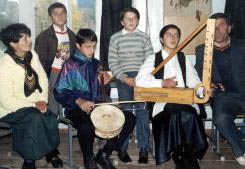
Romeo Pirtskhelani and his family performing with a chunir and a changi (harp) |
Like many of the ancient songs of the high mountain region of Svaneti (see Mirangula and Riho), Lazhghvash has a cryptic text, in this case suggesting maybe a sacrifice — or at least a dedication — of livestock. It's cryptic even to Svans, to whom the primordial songs of their ancestors, songs often connected with pre-Christian rituals, have come down without a user's guide. (The "golden fleece" mentioned may or may not have a connection to Jason, whose Argonauts sailed to the land of Colchis on Georgia's Black Sea coast.) Even the nonsense words are freighted with unspecific meaning, and are assumed to be corruptions of what used to be text or significant names. It's relevant to this progressive mystification of meaning that Svan, while distantly related to Georgian, is not formally a written language — though some of those powerful old names are not the kind of thing you would casually commit to paper even if you could. (Why don't we sing the verse about the ram? Because that's how the people who taught it to us do it, though they carefully give you that verse when you ask them for the words.) Many Svan songs, Lazhghvash among them, can be performed either by two groups of singers antiphonally, or by voices alternating with a chunir solo, the way we do it. |
| Kalospiruli (By the Threshing Floor) |
|
1. O morning breeze! The text of this lyrical harvest song invokes the good will of the forces of nature that govern the task at hand and that can thereby determine the prosperity or ruin of the farmer. For the work to succeed, the breeze is needed to winnow the chaff once the threshing has separated the grain from the husks. Kalospiruli comes from eastern Georgia; the vocal style of the solo, full of the cascading ornaments that can also be heard in Gogo Shavtvala and Orovela, is characteristic of Kakheti. The refrain consists entirely of nonsense syllables. |
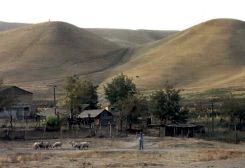
a village in eastern Kakheti |
| Tsmindao Ghmerto (Holy God) |
Holy God, Holy Almighty, Holy Immortal, have mercy on us.
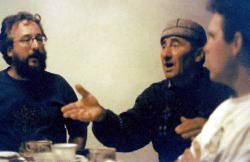
Islam Pilpani teaching us Tsmindao Ghmerto |
This text is familiar throughout Christendom as the Greek Trisagion. A different musical setting, in the eastern Georgian liturgical style, is a much-recorded mainstay of the traditional Georgian repertoire. So far as we know, however, this version from Svaneti is a rarity not recorded by any Georgian ensemble. It's also something of a mystery: We learned it (over dinner) from Islam Pilpani, who presented it to us as Svan liturgical music. That would already set it apart from anything else we know: the best-known sacred songs from Svaneti, Lile and Kviria, are firmly pre-Christian and invoke respectively the sun deity and the fertility deity, so the idea of a Svan setting of the Georgian Orthodox liturgy made us pay attention. But the text is actually in Georgian, not Svan, though the numerous vowel sounds interpolated into the middle of words — "tsminda-yi-wo" instead of the Georgian "tsmindao," for example — are characteristic of Svan singing practice. The musical style, meanwhile, suggest that this is a Svan adaptation of a hymn originally from Guria. So the exact origins of this particular Tsmindao Ghmerto may be in doubt, but its sturdy simplicity is not. (And you can learn it over dinner.) |
| Guruli Vakhtanguri (Gurian Toasting Song) |
1. In one voice, in strict unison let's start,
Let's sing our "Vakhtanguri,"
2. Since life has given us
Merriment and joy.
3. Here's to you, friends!
Live your lives as brothers!
4. Song has such strength
When it drifts into foreign lands.
|
A vakhtanguri is a highly ritualized personal toast: two men at a banquet intertwine their arms and drain to the bottom a matched pair of special wine vessels (usually large ox horns) to symbolize the bond between them. A toasting song in celebration of that ritual of friendship is also called a vakhtanguri, and vakhtanguris come in many musical forms. The text of the fourth verse in our version, Carl's own invention, finds the spirit of the vakhtanguri in the fierce emotional bond we have with the many singers in Georgia to whom we are linked through music. This song permits that kind of textual innovation and personalization — impossible in a song from eastern Georgia — because in trios from Guria the text is secondary and largely interchangeable. Where words are needed, almost anything in the "high shairi" meter (trochaic hexameter, like Longfellow) will do, and some favorite lines get recycled in song after song. The focus remains on the musical setting, and on the opportunities it gives for improvised variations. So, like Me Rustveli and most other Gurian trios, this Vakhtanguri takes its few teaspoons of text and washes them down with a gallon of exuberant scat. The most striking form the scat takes here is a yodel, called krimanchuli, in which the top voice splits across a vocal break, creating an ostinato in two registers, and thereby a virtual fourth part. Krimanchuli is a distinctive feature of music from Guria, where a great krimanchulist is a star. |
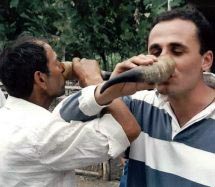
drinking a vakhtanguri toast |
Over time we have been given, by Anzor Erkomaishvili and others, enough background in the grammar of Gurian counterpoint to be able to build on it ourselves. Carl — functioning as our lotbari, or master of all parts — assembled a version of this Vakhtanguri in his head from a number of favorite recordings, new and old, and taught it to the rest of the trio. But, with as many different variants as we learned, it's unlikely that the song can come out the same way twice.
| Harira [nonsense syllables] |
|
Harira is a round-dance song from Samegrelo in four sections, each of which would have a different step pattern. If it were actually being sung to accompany dancers, each section would no doubt be repeated many more times than in this condensed concert version. Apart from the nonsense syllables, there is no text, though the soloist in the last section may improvise some chatter — in Megrelian, of course. In that last section, the dancers stop in a circle and clap while a solo dancer (or a succession of them) takes over the center and puts on a show. This is a case where no living teacher can equal an old master. Noko Khurtsia, a legendary Megrelian singer, recorded in the 1930s what many people consider the definitive Harira. That Khurtsia's version is still accessible now is thanks to an enormous labor of love performed by Anzor Erkomaishvili: In the late 1980s Anzor personally waded through Georgian folk-music archives, listening to everything from formal studio recordings of the 1930s back to a treasure trove of field recordings made between 1907 and the First World War. From all that material Anzor produced for Melodiya a box set of LPs, entitled "The First Records in Georgia," and an extensive series of LPs devoted to individual artists. The value of that resource, for us or for any other singers or scholars of Georgian folk music, is beyond description — as a library of wonderful old "new" variants of songs, or as a record of how intervals were tuned by Georgian singers before they or anybody else had heard Tchaikovsky on the radio. |
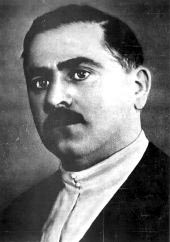
Noko Khurtsia (1905-49) |
| Gandagana (To and Fro) |
1. The river carried along a chip of poplar wood.
Be still, water, and show my beloved's reflection.
2. Girl, girl, merry girl, come here by the riverbank.
Give me a drink from the water jug, sate me with your kisses.
3. Last night I saw you in a dream: your eyebrow was raised,
You stood at the window, your hair in a braid.
4. The hen was driven to the other side, but it cackles on this side.
When I see a handsome boy I tremble like the sea.
5. I had a toy apple, it rolled toward you.
If you hate me and love another, may you be torn up by your roots!
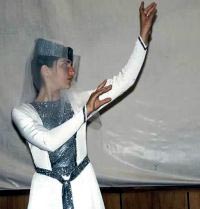
traditional Georgian dancer |
In the mid-20th century many old songs or fragments of songs were strung together in suites and medleys for concert use. The most popular of those arrangements have, in just a few decades, become "traditional" numbers in their own right. The modern form of Gandagana was created as music for a dance company, and the name comes from the motion of the dancers across the stage. The original ballad came from Achara, the southwesternmost part of modern Georgia. Achara was under Turkish control for many centuries, but Acharan traditional music remains very similar to that of neighboring Guria. Songs with a meter in 3, however, are common in Achara and rare in Guria. As for the text, the somewhat discontinuous couplets of the last two verses suggest that these may be lines originally borrowed from different sources or improvised for the sake of the rhyme. (The mysterious line about the toy apple turns up just as unexpectedly in a famous Gurian work song.) The accompanying instrument is the chonguri, and Gandagana is also popular as a chonguri solo. |
| Orovela (Plowing Song) |
1. [no text]
2. Go out and come back, my plow,
Sing the bass, little wheel,
Cut into the ground,
Cut the roots of the weeds.
3. My cherished plow,
With your crooked neck,
You are the bringer of bread,
And the protector of barley.
4. [no text]
|
The meaning of the word orovel is not settled, though it is associated with plowing songs in both Georgia and Armenia, whose languages are entirely unrelated; the word may evoke the name of an ancient god of plowing. Most work songs, like Megruli Naduri on our album, set a rhythm for communal work. But plowing is solitary stuff (if you don't count the oxen), and as a result this famous Kakhetian solo approaches the limit of pure, pulse-free, lyrical recitative. When Orovela moved from the field to the concert stage, an accompanying drone was added: two pitches, the first a fifth below the soloist's second note, the second, halfway through each verse, a step lower. Many great recordings of that simple arrangement exist, most notably that of the Rustavi Ensemble's legendary soloist Hamlet Gonashvili. We have chosen to return to the earlier form of the song, as it might be sung by a solitary plowman in his field — a plowman, however, who had studied with the greatest masters of Kakhetian ornament of his time. Carl's first teacher of ornaments was Hamlet Gonashvili himself, though Carl never met Hamlet, who died in 1985. But Carl had Hamlet's recording of Orovela: to understand what was going on in the cascading loops of ornament, Carl put Hamlet's LP on a turntable and spun it by hand, slowing the ornaments down until he could hear the precise pattern of the vocal turns. Only several years later did Carl find a living teacher; using his Hamlet technique, he sang for Levan Abashidze, director of the Tsinandali Ensemble and a renowned specialist in Kakhetian singing. Since Levan had the advantage over Hamlet of being alive and in the room, he responded, "That's good, but you should do it like this:" and he sang something that was utterly new to Carl, a figure that sounded like it looped around in spirals. It took Carl another year of working on his own, back in the U.S., before he got his voice to produce what he had heard Levan doing — a year of relentless vocal trial and error, mostly done while driving a long commute (the industrial-age equivalent of solitary plowing). |
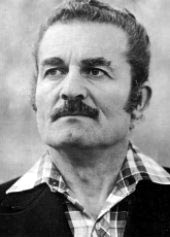
Hamlet Gonashvili [photo: A. Mamulova] |
| Zar (Bell) |
The Zar is a dirge from Svaneti, a ritual song still performed at funerals by the men of the deceased's village. The only word in the song is "wai," an exclamation of grief. Women do not join in the Zar, but instead perform a series of rhythmic wails and screams, often nearby and at the same time as the men are singing. After the Zar has been sung, and the body has been taken by procession to the grave site and buried, family members of the deceased will not sing at all for up to a year. (An American ethnographer we know traveled to Svaneti in 1992 to study singing practices. She got there at the height of the separatist war in the Georgian region of Abkhazia. In an act of collective mourning for the war dead, no one would sing, and she eventually changed her topic to the study of rituals, including funerals.)
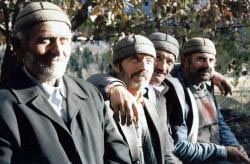
members of the Latal Village Ensemble |
The role of the Zar in daily life remains so significant and so specific that until quite recently Svan choirs hesitated to perform it out of context on a concert stage. When they did, they were heckled with remarks like, "If you don't stop, it will be somebody's funeral!" But it is clear to most Svans that the Zar represents, in distilled form, the tonal language unique to Svaneti, and that it deserves to be heard as music. It has only one word of text and a musical structure of extreme simplicity, but among ourselves we often call this Zar "The Hardest Song in the World." The reason is tuning: this song lies at the extremity of the quintave tuning system described in the introduction. For native Svans, born to this music, tuning this way is as natural as breathing; for us, born in a softer land and emigrants to Georgian music as adults, it's like breathing the fierce, intoxicating air of another, more ancient planet. The musical form of the song varies slightly from village to village; the version we sing is from Latal, near Mestia. We learned it from a concert recording of the Latal Village Ensemble, since even the staunchest singers we met in Svaneti seemed reluctant to put themselves through the Zar without cause. |
| Didi Khnidan Gagitsani (I've Known You a Long Time) |
1. I've known you a long time.
God keep you from harm.
2. You are strikingly beautiful.
Your head and neck are especially nice.
3. Who raised you up such a beauty,
To be the assassin of me and my heart?
4. God bless the parent
Who gave birth to you!
In the sequence of toasts that are the inseparable accompaniment to the drinking of wine at a Georgian table, the toast to the memory of the dead (whether specific persons recently deceased or "those who have gone before us" in general) is traditionally followed by the toast to children, who represent life and hope for the future.
We learned this song from Anzor Erkomaishvili, who has undoubtedly been singing it since he was three years old. A culture that successfully carries forward an ancient tradition of singing has to be vigorous about training its young: Georgian children barely old enough to talk are taught to sing, and almost immediately they are expected to be able to hold onto a part by themselves while their parents or siblings sing thorny counterpoint. On several occasions, in the home of one eminent singer or another, we have been treated to a performance of Didi Khnidan Gagitsani by the great man's very young children or grandchildren. This little Gurian trio contains, on a manageable scale, the entire toolbox of quintave counterpoint and interchangeable variants that those children will need when they grow up and take on pyrotechnic extravaganzas like Me Rustveli and the Guruli Vakhtanguri — thereby carrying the ancient art of Georgian folk music into the future.
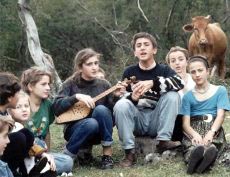
|
back to start of song notes
return to Kavkasia home page |